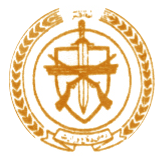
Almanac
Afghanistan, Islamic Republic of


Surgeon General
Dr Hashmatullah NAWABI
Lieutenant General
Wazir Akbar Khan Road
Kabul
AFGHANISTAN
Pictures and Graphics: Wikimedia Commons
Attention: The information on this page has not been updated since the Taliban government was established in August 2021.
Vision
Having a strong and self-sustaining healthcare system in accordance with international standards for the Afghanistan National Army (ANA).
Basic Task of the Military Medical Service
- Education and training
- Treatment and medical ground evacuation
- Prevention
- Medical logistics
- Consolidating discipline
- Continuously monitoring of all health institutions
- Developing and improving the job description of every echelon.
- Creating internal SOP for all ANA hospitals.
- Developing and implementation for transition plans after 2014
- Reducing the mortality rate
- Good leadership
- Provide rehabilitative services to soldiers
- Incorporate Air Transportable Transfer Units into the health care system
- Taking into account transparency and accountability
- Reform of organizational formation and equipment tashkil
Structure
The Medical Command (MEDCOM) office is a department within the General Chief of Staff of Ministry of Defence. Medical Command is responsible for the overall health and welfare of all Afghan National Army and police soldiers. This includes the ANA central hospital, annexe hospital, regional hospitals, clinics, brigade-level troop medical clinics (TMC), infantry medics and Combat Physician Assistants from the corps down to small unit level.
Military Hospitals
The ANA has 6 main hospitals located throughout the country. The National Military Hospital (NMH) in Kabul is the largest hospital in Afghanistan providing a high level of general and specialized services to include general surgery, thoracic surgery, orthopaedic surgery, trauma surgery, plastic and burn surgery, maxillofacial surgery, neurosurgery, ENT, urology, emergency medicine, internal medicine, cardiology, nephrology, dermatology, obstetrics, radiology, pediatric, PACU/ICU, ophthalmology, neuro-psychiatry, blood bank, lab, and nursing.
MEDCOM incorporates 5 regional hospitals located in Kandahar, Gardez, Herat, Mazar-e-Sharif and Jalalabad. An additional regional hospital is currently being built in Helmand. NMH has a capacity for 410 beds while the regional hospitals have a 100-bed capacity. To ensure communication, each regional hospital reports to Medical Command daily in a teleconference.
| Hospitals | Beds | Location | Departments |
| NMH | 410 beds | Kabul | 25 |
| Kandahar regional hospital | 100 beds | Kandahar | 20 |
| Gardezregional hospital | 100 beds | Paktia | 20 |
| Herat regional hospital | 100 beds | Herat | 20 |
| Mazar -e- Sharif regional hospital | 100 beds | Balkh | 20 |
| Gambari regional hospital | 100 beds | Jalalabad | 20 |
Source: Ministry of Defence Afghanistan
Regional Medical Facilities
There is a total of 5 regional medical facilities and 31 Troop Medical Clinics (TMC). The regional medical facilities have professional staff and are well-equipment. There are future plans to install CT scanners in each regional medical facility. The hospitals provide the 3rd echelon of care that includes, surgery and postoperative treatments. At the regional hospitals, the patients are stabilised and when appropriate return to duty or continue with the theatre evacuation policy and transferred to the National Military Hospital in Kabul.
Troop Medical Clinics
The garrison troop medical clinics (TMC) provide 2nd echelon of care. They have the capability to provide emergency medical treatments, to include initiating resuscitation. At the medical company, the patient is examined and vitals are evaluated to determine best treatment and evacuation urgency either as a single casualty or a collection of other casualties. ANA mostly do the ground evacuation 90 %.
There are more than 1000 well-equipped ambulances and 10% of evacuation was done by ANA Air Force.
Number of Medical Personnel
| Staff | Authorize | Assigned | Shortfall | Students in AFAMS | |
| Doctor | 753 | 609 | 144 | 175 | |
| CPA | 632 | 596 | 36 | 70 | |
| Pharmacists | 119 | 97 | 22 | 24 | |
| Nurse | 479 | 393 | 86 | 20 | |
| x-raytech | 58 | 46 | 12 | 0 | |
| Dental tech | 54 | 49 | 5 | 6 | |
| Anesthesia | 37 | 31 | 6 | 0 | |
| Functional diagnosis | 12 | 7 | 5 | 0 | |
| Physical traphy | 29 | 25 | 4 | 12 | |
| Preventive med | 58 | 38 | 20 | 15 | |
| Bio med | 34 | 25 | 9 | 6 | |
| Lab | 97 | 61 | 18 | 0 | |
| Total | 2362 | 1977 | 385 | ||
| Combat Medic | Authorized | Assigned | Shortfall | ||
| NCOMEDIC | 2474 | 1619 | 855 | ||
| MEDIC | 3774 | 2835 | 939 | ||
| Total | 6248 | 4454 | 1794 | ||
Training
The Armed Forces Academy of Medical Sciences (AFAMS) serves as the Afghan Security Forces Medical Education and Training Center providing medical care education, individual skills training, leadership development and unit collective training programs necessary to meet the operational requirements of the ANA and other Afghan National Ministries. Courses range from enlisted medical speciality courses to graduate medical education residency courses. The eight Warrior Care Residency Programs include Internal Medicine, General Surgery, Orthopedics, Preventive Medicine, Anesthesiology, ENT, Urology, and Critical Care. Specific training courses include Basic Military Physician, Combat Physician Assistant, Combat Medic, Medical Officer Basic, Medical Non-Commissioned Officer, Medical Logistics, Nursing, Nursing Assistant, Laboratory Technician, Radiology Technician, Preventive Medicine Technician, Ultrasound Technician, Dental Therapy, Pharmacy Technician, Biomedical Technician, and Physical Therapy. AFAMS is considered a Center of Excellence in Afghanistan and represents the highest calibre military care available in the country. Graduates from the AFAMS programs are sent throughout the country to provide care to all ANSF members.
sources tables: Ministry of Defence Afghanistan
(status: 18 June 2025)











